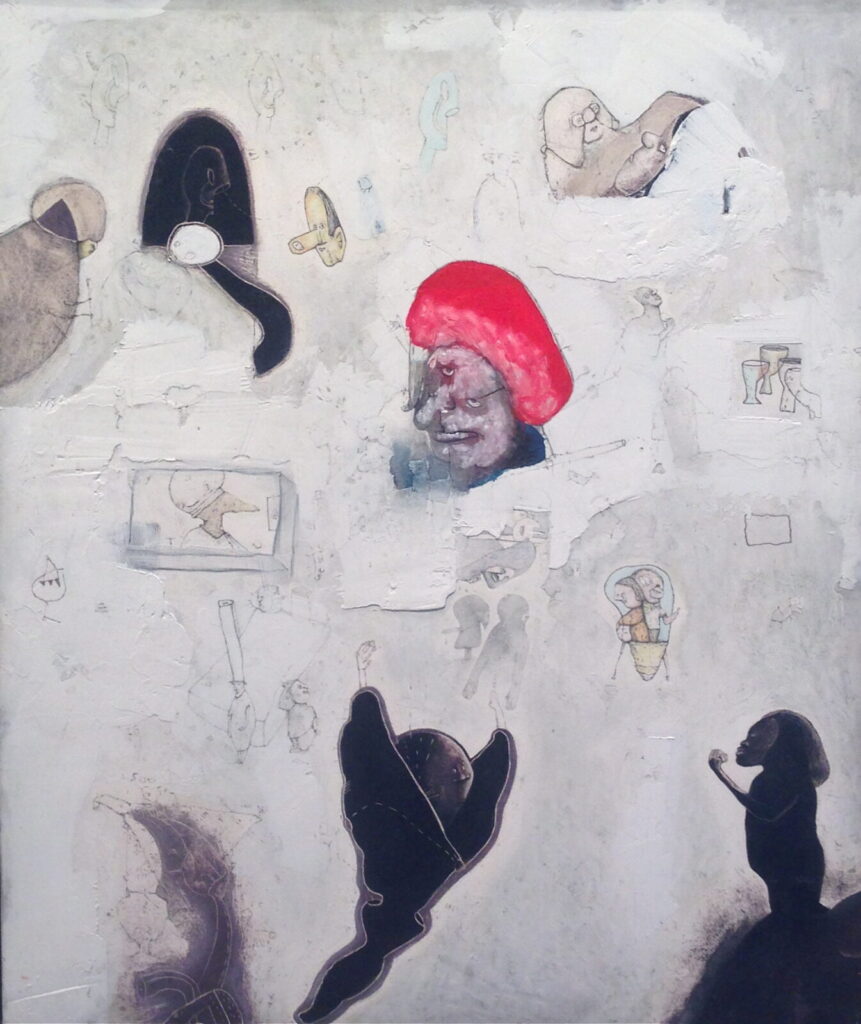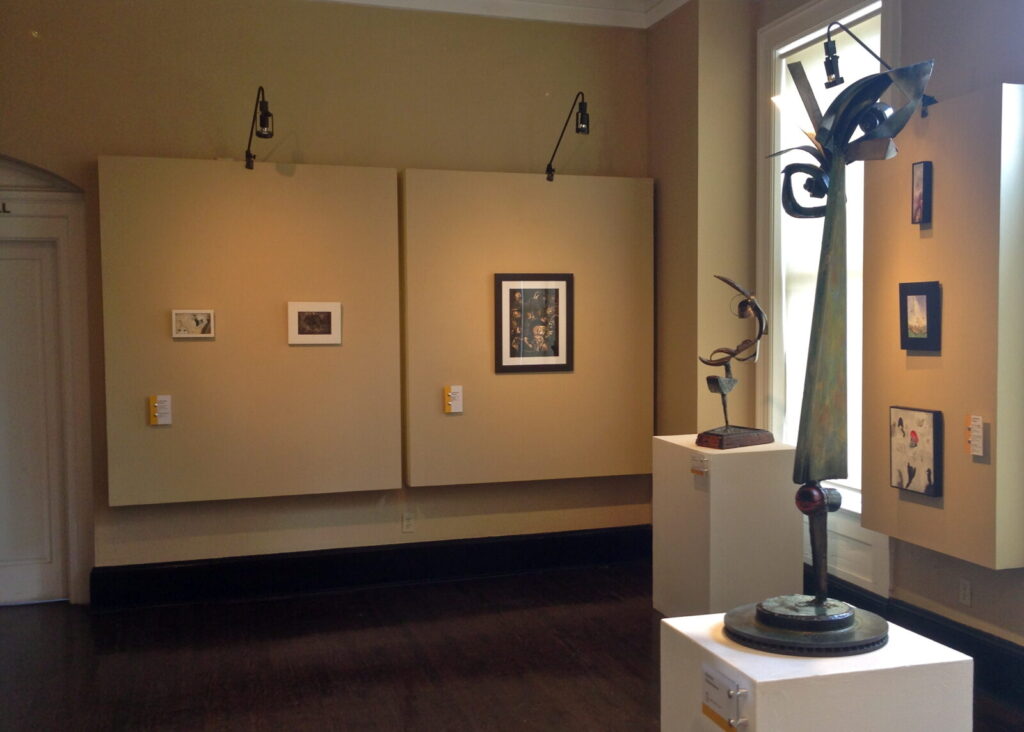Sparks & Marks, an exhibition on view at Arts Place Gallery in downtown Lexington pairing works made by local artists Gordon Gildersleeve and Lawrence Tarpey, offers two individuals who are to be regularly counted amongst local artists of caliber. Gildersleeve creates an array of sculptures and furniture from a combination of wood, stainless steel, and other metals while Tarpey’s two-dimensional works earn their distinction from their miniature sizes and expressive marks. Both artists incorporate fantastical as well as figurative elements into the objects they make: it is this commonality that is the foundation of Sparks & Marks.

Indeed, the similarities between Gildersleeve and Tarpey are prime for a lively duet. The majority of sculptures on display contain abstracted faces made from minimal amounts of metal scraps and barn wood. Likewise, the selection of Tarpey’s etchings is largely grayscale and comprised of individual scenes featuring small numbers of figures, animals, and undetermined shapes. Tarpey’s approach to storytelling is modest and vague: large areas of his etchings are dedicated to materiality and texture, exemplified by works like Red’s World (n.d). In Sparks & Marks, deliberate use of negative space is pressing here. The exhibition positions Gildersleeve and Tarpey as masters of their chosen materials who understand the visual footprint of each object they make.

Although these two artists are alike in the ways in which they incorporate negative space into their objects, they differ in their chosen subject matter—Tarpey’s scenes provoke feelings of ambiguity and transcendence while Gildersleeve’s sculptures push the boundaries of abstract figuration. Yet this difference cues another comparison. Tarpey’s dreamy depictions resemble compositions made by modern masters such as Marc Chagall and Joan Miro. Additionally, Gildersleeve seems to channel famous cubists like Picasso and Georges Braque. For this reason Sparks & Marks serves as an exploration in how the lineage of these notable art historical figures is continued on a local level.
With 49 objects in total, Sparks & Marks fully allows the idiosyncrasies of each artist to be present in the gallery. Those familiar with Tarpey’s practice will recognize many of his works in the exhibition employ the techniques and content they are used to seeing, including additive and reductive processes as well as amorphous forms. These and more are on display, as are examples of Tarpey’s recent experimentations in digital painting. Gildersleeve’s expansive practice is marked by metal renderings of human figures, birds, and everyday objects as well as pieces of furniture. Sparks & Marks emphasizes the abilities of both Gildersleeeve and Tarpey by means of an eclectic checklist, ensuring that each visitor realizes the extent to which these two artists deserve notoriety.
In the gallery, however, visitors are likely to feel crammed as they move through the space due to the amount of works on display. Arts Place Gallery is an accommodating gallery split in two sections, but the room is unable to maintain its spaciousness when it holds nearly fifty works. The exhibition design limits the audience’s ability to move freely around each work and consequently visitors are subjected to minimal viewing angles. While the checklist for Sparks & Marks demonstrates the impressive talents of each artist, it makes for a congested arena for art and viewer to interact.
Additionally, the checklist includes what seems like multiple bodies of work from each artist. Notably, Gildersleeve’s diverse subjects—human forms, faces, birds, and furniture—assist in preventing Sparks & Marks from making the strongest connection possible between its two featured artists. At times, this all-encompassing exhibition feels more like a showcase for two artists who are relatively similar and less like a study in specific regional aesthetic trends.
In spite of this, the number of works in Sparks & Marks detail the trajectory each artist has taken with his own work to arrive at their current states. The gallery acts as a roadmap that highlights Gildersleeve’s and Tarpey’s progression with subject matter, materials, and craftsmanship. Specifically, Tarpey’s path as a small-scale painter to a digital artist is encouraging and compelling—it is a humbling moment for those who have closely followed Tarpey’s career. In the same vein, the 49 objects are on loan from galleries, collectors, and the artists themselves. Gildersleeve and Tarpey clearly have support from members of the greater community, and Sparks & Marks sets out to make that known. It is a vague connection between the two artists, however, that is the exhibition’s shortcoming.
Sparks & Marks runs from July 14th to August 27th, 2016 at Arts Place Gallery, Lexington, KY.




